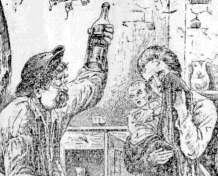




















|
|

Since there were few doctors to serve a widespread population, most Canadians relied on home remedies and care. Many almanacs carried recipes designed to cure almost anything, and, in the later years, advertisements for a variety of miracle products.
The medical history of countries is often one of a series of epidemics and Canada is no exception. Typhus, cholera, venereal disease, and tuberculosis had outbursts throughout Canadian history and gave rise to numerous publications for their prevention and cure.
Although announcements of births and marriages are rather late occurrences in the printing history in this country, funeral notices were printed by most of the 18th-century Canadian printers.

Much information on the activities of early Canadian doctors has reached us through the almanacs they used as agendas. This copy belonged to well-known doctor William Bruce Almond (1787-1840) of Halifax. He has written up a list of persons vaccinated in 1810 and 1811 - probably against typhus - which included Judge Haliburton and his son, the future author of The Clockmaker. It was the son of the printer of this almanac, Joseph Howe, who published The Clockmaker in 1838. In June 1840, Dr. Almond contracted typhus after attending to passengers of a ship moored in Halifax, and died a few weeks later.
An Almanack for the Year of Our Lord, 1811, ...: Calculated for the Meridian of Halifax, in Nova-Scotia.
Halifax: Printed and sold by John Howe & Son, [1810].

Certain almanacs were published by distributors of pharmaceutical products. One finds advertisements for different products such as, in this case, the Perry Davis Pain Killer, "reputed" treatment against cholera - which continued to claim victims - mixed in with kitchen recipes. This ad boasts of the effectiveness of bear grease for the hair. This copy has the stamp of Dr. G.W. Prentiss of Grenville (Quebec).
Davis & Lawrence (Montreal)
Pain Killer Calendar and Cookery Book.
[Montreal?], 1886.

This almanac advertises Mother Siegel's syrup, pills and ointment, and contains letters from satisfied customers written from different parts of Canada. One suspects that the same letters were updated over the years. This copy was distributed by Dr. G.W. Prentiss of Grenville (Quebec). It has attractive lithographed wrappers, and shows the string with which the almanac could be attached to a prominent place in the kitchen.
|

|
Mother Seigel's Almanac. 1889.
[Montreal: A.J. White & Co., 1888].
|

This is the same type of advertising almanac, but this time for Dodd's kidney pills. It contains testimonials from different Canadians mixed with "medical information." This almanac was sent by mail to clients. Our original envelope is postmarked December 9, 1942.
Dodd's Almanac. 1943. Useful Information for Family and Home.
[Toronto]: The Dodds Medecine Co. Ltd., [1942].

The fight against intemperance was continuous, but intensified around the turn of the century. This almanac contains stories showing the dangers of alcohol, and reproduces drawings designed to show the harmful effects of alcoholism on the family. This publication was mainly distributed in the Gaspé area and on the North Shore.
|

|
Almanach du buveur pour 1907.
Rimouski, Québec: Imprimerie générale de Rimouski, [1906?].
|

During a certain period, works of popular medicine, breaking away from traditional medicine, were very popular in Canada. Samuel Thomson, an American, and his followers believed that sickness was mainly due to a loss of heat and treated their patients with remedies of vegetable origin such as cayenne pepper. But there was more than medicine in these first popular manuals published in Upper Canada. Thomson was also an ardent republican and conveyed his reformist beliefs in his works. It is not a coincidence that three editions of this work were published in Upper Canada by reform printers and distributed in all of southern Upper Canada on the eve of the 1837 Rebellion.
Samuel Thomson, 1769-1843
New Guide to Health; or, Botanic Family Physician.
Brockville [Ont.]: Printed for W. Willes, by W. Buell Jr. & Co., 1831. 192, 132 p.

|
